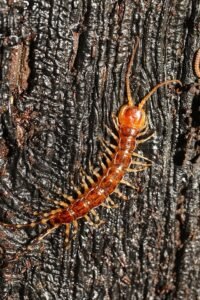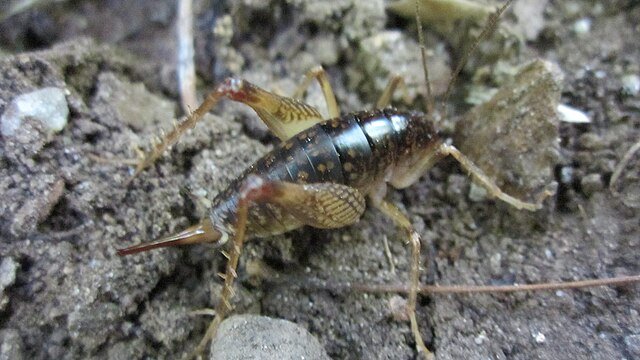Stone Centipedes (Lithobiomorpha)
 If you have ever lifted a stone or flowerpot in your garden and saw a fast-moving, flat brown creature scurrying away, you have likely met a stone centipede (Lithobiomorpha).
If you have ever lifted a stone or flowerpot in your garden and saw a fast-moving, flat brown creature scurrying away, you have likely met a stone centipede (Lithobiomorpha).
These arthropods look intimidating, but in most cases, they’re not pests — they’re actually beneficial predators that help control populations of insects, mites, and other soil-dwelling organisms. Still, their sudden appearance inside homes or basements often causes alarm.
I’ve been called many times to “centipede infestations” that turned out to be harmless Lithobius forficatus (the common European stone centipede). So, before you panic, it’s important to understand what these creatures really do — and why, in most cases, you actually want them around.
Identification
Stone centipedes belong to the order Lithobiomorpha, one of the largest and most diverse centipede groups.
Here’s how to recognize them:
Scientific name: Lithobius forficatus and other Lithobiomorpha species
Common names: Stone centipede, brown centipede, ground centipede
Body length: 2–4 cm (0.8–1.5 inches)
Color: Light brown to reddish-brown
Body shape: Flattened, divided into 15 visible segments, each with a pair of legs
Legs: 15 pairs, with the last pair longer and used for defense
Antennae: Long, segmented, and highly sensitive
Habitat: Under stones, logs, bark, leaf litter, and moist garden soil
If you see a small centipede that darts quickly when exposed to light, it’s almost certainly a stone centipede — not a pest like silverfish or earwigs, though it may share their habitat.
Biology and Ecology
The biology of Lithobiomorpha is fascinating because they’re among the most ancient terrestrial predators — they’ve existed for over 400 million years.
Life cycle:
Eggs: Females lay eggs individually in soil or under debris.
Juveniles: Hatch with fewer legs (usually 7 pairs) and gain more with each molt.
Adults: Reach maturity in about 1–2 years and can live up to 5 years in good conditions.
Feeding habits:
Stone centipedes are nocturnal predators. They feed on:
Insects (ants, beetle larvae, springtails)
Spiders
Small worms
Other arthropods
They use modified front legs called forcipules to inject venom into prey — a structure unique to centipedes. The venom is not dangerous to humans but is highly effective against small insects.
Preferred conditions:
Moisture: High humidity, shaded areas
Temperature: 10–25°C
Environment: Gardens, forests, basements, compost piles, under stones and tiles
Their presence usually signals a healthy ecosystem — plenty of organic matter and microfauna.
Global Distribution
Stone centipedes are found almost everywhere on Earth, except for the coldest Arctic and Antarctic regions.
Europe: Most common in the UK, Germany, Greece, France — especially in gardens and old houses.
North America: Lithobius forficatus and L. peregrinus are well established.
Asia: Native species are abundant in Japan, India, and China.
Australia: Introduced species coexist with native soil centipedes.
Their wide distribution shows how adaptable they are — they can thrive from cool forests to urban environments.
Risks and Damage
Here’s the truth: stone centipedes are not harmful to property or humans.
They don’t damage food, clothes, or wood.
They don’t reproduce indoors; they accidentally wander inside looking for prey or shelter.
Their venom is too weak to hurt humans; at most, a mild sting may occur if handled roughly.
In fact, their diet helps reduce populations of real pests like cockroach nymphs, termites, or ants.
The only “risk” is psychological discomfort — people often find them creepy because of their many legs and fast movement. But biologically, they’re allies, not enemies.
Signs of Infestation (or Presence)
Stone centipedes don’t create nests or colonies, so you’ll never find an “infestation” in the usual sense. However, here are some signs they are present nearby:
Sightings under stones, tiles, or mulch
Finding one or two indoors during damp weather
Small insect carcasses near their hiding places
Moist areas like basements or bathrooms attracting them
If you’re seeing several per week indoors, it usually means your house has excess humidity or plenty of small insects for them to feed on.
Control Methods
Because stone centipedes are beneficial, control should focus on exclusion rather than killing. Still, here’s what I recommend when clients find them inside:
1. Reduce Moisture
Fix leaks in basements or bathrooms.
Improve ventilation and use dehumidifiers.
Avoid overwatering indoor plants.
2. Seal Entry Points
Caulk cracks in foundations, window frames, and door thresholds.
Install fine mesh screens over drains and air vents.
3. Remove Shelter
Clear piles of leaves, wood, or stones near the house.
Trim vegetation that touches walls.
Keep mulch at least 20–30 cm away from the foundation.
4. Manage Prey Insects
If you have ants, spiders, or silverfish, centipedes will follow. Controlling those species often eliminates the reason centipedes enter in the first place.
5. Physical Removal
Simply catch them using a jar and release them outside. No need for sprays.
6. Chemical Control (Only if Necessary)
Residual insecticides (e.g., pyrethroids) can be used along baseboards or entry points in severe cases. However, these should be applied sparingly and only by licensed pest control professionals, since unnecessary spraying harms beneficial arthropods.
Advanced Approaches
In modern pest management, centipedes are considered part of the natural control team. Integrated Pest Management (IPM) strategies include them as predator allies, not targets.
However, if control is required:
Desiccant dusts like diatomaceous earth can be applied to cracks.
Barrier treatments (non-repellent formulations) can prevent indoor entry.
Environmental modification — keeping the perimeter dry and debris-free — remains the most effective long-term measure.
In sustainable pest control, the goal isn’t to kill everything that crawls — it’s to maintain ecological balance so pests can’t dominate.
Cultural and Historical Context
Stone centipedes have a long history in folklore. In many Mediterranean cultures, they were believed to predict rain when seen near doors.
In rural Europe, some thought they were poisonous like snakes — a myth likely born from their speed and appearance.
In modern times, they’ve gained an odd respect among biologists. Their simple, segmented anatomy helped scientists understand the evolution of arthropod locomotion.
So while most people squash them on sight, researchers see them as living fossils that tell a story millions of years old.
FAQ Section
1. What are stone centipedes?
They are small, brown, fast-moving centipedes from the order Lithobiomorpha. They live under stones, logs, and soil, feeding on insects.
2. Do stone centipedes bite humans?
Rarely. They may pinch if handled, but their venom is too weak to harm humans.
3. Are stone centipedes dangerous?
No. They don’t spread disease, damage property, or infest homes.
4. Why do I find them in my house?
Usually because of humidity or other insects. They enter accidentally while searching for prey.
5. How do I get rid of them?
Reduce moisture, seal entry points, and manage other insects that attract them.
6. Are they beneficial?
Yes — they help control pests like cockroaches, termites, and spiders.
7. Can I use insecticides against them?
Only as a last resort. Physical removal and prevention work best.
8. Do they live in groups?
No. They are solitary hunters.
Final Thoughts
After decades of pest control work, I’ve learned that not every crawling creature deserves elimination. The stone centipede (Lithobius forficatus and related Lithobiomorpha species) is a perfect example of this misunderstanding.
Homeowners often panic when they see one dart across the bathroom floor, assuming an infestation — but in reality, they are nature’s pest control technicians. They hunt down small insects, keeping other pests in check without any chemicals.
If you find one indoors, it’s usually a sign that conditions are too damp or there’s prey available. Fixing those underlying issues is far more effective than spraying insecticide.
In pest management, I always say:
“When you see a stone centipede, your home is not dirty — it’s just too comfortable for small creatures.”
Understanding the biology of beneficial predators helps us work with nature, not against it. A dry, well-sealed, and clean environment will naturally send them back where they belong — under stones, doing the good work for free.
Disclaimer
This article is for informational purposes only. Pest control laws and approved chemicals vary by country. For best results and legal safety, we strongly recommend contacting a licensed pest control professional in your local area. Always make sure that the pest control technician is properly certified or licensed, depending on your country’s regulations. It’s important to confirm that they only use approved products and apply them exactly as instructed on the product label. In most places in Europe, UK, or USA, following label directions is not just best practice—it’s the law.
Author
Nasos Iliopoulos
BSc Agronomist & Certified Pest Control Expert
Scientific Director, Advance Services (Athens, Greece)
Licensed Pest Control Business – Ministry of Rural Development & Food (GR)
References
Wikipedia -Lithobiomorpha
Britannica -Stone Centipedes

